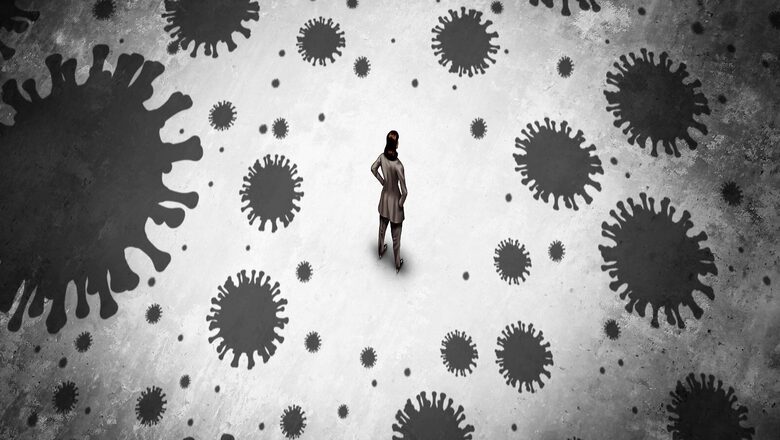
views
Mental disorders are the second leading cause of disease burden in terms of years lived with disability (YLDs) and the sixth leading cause of disability-adjusted life-years (DALYs) in the world in 2017, a study by The Lancet revealed.
It also states that mental disorders are among the leading causes of non-fatal disease burden in India.
In 2017, one in seven Indians were affected by mental disorders of varying severity. And since 1990, the overall contribution of mental disorders to the total disease burden in India has almost doubled. Over time, the trends of these diseases were also seen changing amid various states. Battling an increasing burden of mental illness, India reels under a huge shortage of number trained mental professionals. As per the National Survey of Mental Health Resources carried out by the Directorate General of Health Services, between May and July 2002, against the required 11,500 psychiatrists in the country, only 3800 existed. And the World Mental Health Atlas 2014 mentions the number of psychiatrists as 0.30 per 100,000 population. The World Health Organization (WHO) data showed that in India, (per 100,000 population) there are psychiatrists (0.3), nurses (0.12), psychologists (0.07) and social workers (0.07), while the desirable number is anything above three psychiatrists and psychologists per 100,000 population.
Along with this, the number of suicides in India is increasing at an alarming rate. National Crime Records Bureau (NCRB) data states that a total of 1,39,123 suicides were reported in the country during 2019 showing an increase of 3.4 per cent in comparison to 2018 and the rate of suicides has increased by 0.2 per cent during 2019 over 2018.
How Affordable is Mental Health Treatment in India?
India not only deals with disease burden but lacks affordability, accessibility of treatments and awareness around mental illnesses. A 24-year-old journalist, who wishes not to be named said, “During the pandemic at a point in time, my weekly therapy session seemed like a luxury. As an independent woman, after I started working, I never asked for money from my parents but after paying for rent and food, I was left with nothing. I had to ask for money to keep myself active for my therapy sessions.”
Talking about the exorbitant cost of therapy sessions, a well-paid 34-year-old, software engineer said, “Every therapy session cost me Rs 1500, and I used to take four in a month, maintaining mental health is a luxury affair. And I am sure people who cannot afford it leave in the middle of treatment, making themselves more vulnerable.”
With decreasing public spending on healthcare, the private sector has remarkably grown over years, making it difficult for low-income populations to access mental healthcare treatments. However, over the years, there has been no enthusiasm from the government either in increasing the spending on mental healthcare infrastructure.
The Union Budget 2021-22, proposed a corpus of Rs 71,269 crore for the Ministry of Health and Family Welfare, which included a budget for mental healthcare – a total of Rs 597 crore. Shockingly, only 7 per cent of the entire budget went to the National Mental Health Programme (NMHP), Rs 57 crore for Lokpriya Gopinath Bordoloi Regional Institute of Mental Health in Tezpur and the rest went to the National Institute of Mental Health and Neuro Sciences (NIMHANS) in Bengaluru (Rs 500.44 crores).
Where Does Rest of the World Stand in Mental Healthcare Spending?
In a survey published by the World Health Organisation, it says the pandemic has halted critical mental health services in 93 per cent of the countries. However, prior to the Covid-19 outbreak, countries were spending less than 2 per cent of their national health budgets on mental health and were still struggling to meet their populations’ needs.
The World Health Organisation (WHO) found that over 60 per cent reported disruptions to mental health services for vulnerable people, including children and adolescents (72 per cent), older adults (70 per cent), and women requiring antenatal or postnatal services (61per cent). A total of 67 per cent saw disruptions to counselling and psychotherapy; 65 per cent to critical harm reduction services; and 45 per cent to opioid agonist maintenance treatment for opioid dependence.
Data shows that around 80 per cent of people with mental illnesses live in low-income countries, out of which nearly 75 per cent never receive treatment. Although there is a significant gap between high-income and low-income countries’ spending on mental health, on average, countries spend only 1.7 per cent of their health budgets on mental health. For many high-income countries, the health budget allocated to mental health is over 3 per cent, while for developing countries it is less than 0.5 per cent.
In Australia, the government allocated an annual budget $2.3bn mental health package that also includes the establishment of a National Suicide Prevention Office and a new network of mental health counselling clinics for Australians aged over 25 that will be set up across the country.
Amid the pandemic, the United Kingdom government has promised an extra £2.3 billion a year to transform mental health services by 2023. But the experts are calling for additional funds on top of existing government commitments to tackle other issues such as the poor condition of mental health buildings, The Guardian reported.
Mental Health Stigma is Deep-rooted
There is more chatter around mental health in popular culture, social media and in the news and more people are talking about it now than ever before, but does this mean it is easier for someone with a mental illness to talk about it?
The World Health Organisation states that approximately 280 million people around the globe have depression and over 7,00,000 people die due to suicide every year. Suicide is the fourth leading cause of death in 15-29-year-olds.
Mental health disorders affect people of every age, caste, creed, colour or sexual orientation yet one of the biggest challenges is the stigmas attached to it. Dr Brock Chisholm, the first Director-General of the WHO, in 1954, had presciently declared that “without mental health, there can be no true physical health.”
“I have been called out a lot of times for my overthinking, which is beyond my control. And there is a feeling of dealing with it on my own, which is why I haven’t told a lot of people about my therapy sessions. However, going to psychotherapy, makes you learn a lot about yourself- both negatives and positives,” says 23-year-old, Arpit Chaudhary. And since mental health issues can actually haunt you in ways one cannot imagine, it is better to treat them on time before it affects your health, he added.
The stigma surrounding mental health is internalised by individuals, which acts as a barrier for individuals to seek professional treatment.
From my own experience, taking mental health therapy was the best decision that transformed my life as an individual but it took me months to come out and tell my ‘open-minded’ family about it, it is nothing else but stigma that surrounds ‘therapist visits’. After five to six months of healing, I could talk about something that was so emotive at a deeply personal level, and fight that constant feeling of being exposed and judged.
“Stigma is still prevalent, only policy level and organizational level changes can help us fight it,” a Delhi-based systemic family therapist Reena Nath who has worked in several countries including UK and Afghanistan told News 18.
Need Better Cooperation on Mental Health
The increasing global burden of mental illnesses exposes a labyrinth of lack of resources, lack of affordable services, dearth of accessible treatments, and above all the stigma that surrounds it.
However, in order to solve the global crisis, the World Economic Forum (WEF) believes that a global-level consolidation of efforts is essential to address systemic issues affecting the provision of care. And to be successful in achieving the desired target, there has to be active participation from both the public and private sectors.
The WEF states there are five priorities- the need to have a multi-stakeholder collaboration (grassroots level workers, NGOs, government, private and public sector, and academic institutes) to advance local, national, and global efforts in favour of good mental health. Second, there need to be technological-centered policies for early diagnosis and prevention of mental ill-health. Third, improve access to treatments. Fourth, Improve care pathways and insurance schemes for treating specific mental disorders. And Fifth increase the number of mental health specialists- Psychiatrists, Social workers, psychologists, and researchers.
Read all the Latest News , Breaking News and IPL 2022 Live Updates here.


















Comments
0 comment